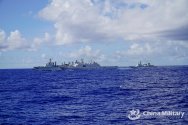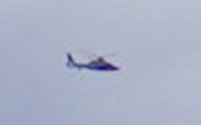Now this is interesting OVH radar ship with enormous radar coverage via Han patriot
Chinese navy’s new ‘compact’ radar will allow it to keep watch over an area the size of India
Chinese military scientists have made significant headway in upgrading China’s radar technology, and are developing an advanced “compact size” radar for the navy’s carrier fleet that will allow it to maintain constant surveillance over an area the size of India.
The improved system will enable the Chinese navy to spot incoming threats from enemy ships, aircraft and missiles much earlier than the existing technology allows, according to scientists who chaired China’s Over-the-Horizon (OTH) radar programme.
The programme emerged into the public spotlight on Tuesday when its lead scientist, Liu Yongtan, a professor with the department of electric and information engineering at Harbin Institute of Technology, received China’s top science award from President Xi Jinping at a national ceremony.
Another military scientist, Qian Qihu, was also honoured at the event in the Great Hall of the People in Beijing on Tuesday for his work on underground nuclear shelter facilities.
Liu told state media that land-based, over-the-horizon radar had greatly increased the range of an area the PLA could monitor.
“Relying on traditional technologies, our surveillance and monitoring could only cover about 20 per cent of our maritime territory,” Liu told state news agency Xinhua. “With the new system, we can cover the whole area.”
Land-based OTH radars were first developed by the US and Soviet Union during the cold war, letting them keep watch over thousands of kilometres of territory by sending radio waves up into the ionosphere and bouncing them back to earth.
However, many of these facilities have since been shut down or suspended due to their vulnerabilities.
The radars need enormous amounts of power and have to be built on flat and open terrain.
Deploying the technology at sea means scientists have to overcome a number of challenges, including adjusting the radar’s frequency, depolarisation and direction to match the distance of the target zone and conditions in the ionosphere.
Their immobility also makes them highly vulnerable to attack, prompting military planners to shift their focus to airborne early warning and control systems.
However, a senior member of Liu’s team confirmed to the
South China Morning Postthat the new system would be a ship-based OTH radar system.
The floating radar “will increase our navy’s information gathering capabilities in critical areas” including the South China Sea, Indian Ocean and Pacific Ocean, said the researcher, who requested anonymity because of the sensitivity of the issue.
Deploying the technology at sea means scientists have to overcome a number of challenges, including adjusting the radar’s frequency, depolarisation and direction to match the distance of the target zone and conditions in the ionosphere.
The receiving ship also must use complex techniques to compensate the motion caused by the sea.
China is not the only nation developing the technology. The Raytheon Company, a major US defence contractor, was granted a patent in 2016 for a similar system.
The Raytheon design involves a transmitting vessel and several receiving ships with antennae mounted on the deck.
Radio waves are directed into the sky by the transmitter to be collected by the receiving ships, which then pass on the signals to aircraft carriers via satellite or airborne relays.
According to Raytheon, the system has a detection range of over 1,000km (620 miles) and can cover an area of more than one million square nautical miles – the equivalent of 3.4 million square kilometres, which is about the size of India.
By contrast, the radar range of a US naval destroyer is about 300km while a Boeing E-3 Sentry radar can reach more than 600 kilometres.
The designs of the Chinese system remain classified, according to some mainland radar scientists.



